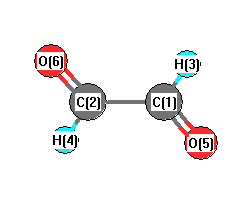.
| squib |
reference |
DOI |
| 1966Herzberg |
Herzberg, G., Electronic spectra and electronic structure of polyatomic molecules,Van Nostrand,New York, 1966 |
|
| 1997Hub/Lee:221-236 |
H Hubner, A Leeser, A Burkert, DA Ramsay, W Huttner "Microwave Spectra, Dipole Momentsm and Torsional Potential Function of cis-Glyoxal and cis-Glyoxal-d1" J. Mol. Spect. 184, 221-236 (1997) |
10.1006/jmsp.1997.7327 |
| 1998Kuc |
K Kuchitsu(ed) "Structure of Free Polyatomic Molecules - Basic Data" Springer, Berlin, 1998 |
10.1007/978-3-642-45748-7 |
| Shim |
Shimanouchi, T. , Tables of Molecular Vibrational Frequencies, Consolidated Volu |
10.6028/NBS.NSRDS.39 |
| TRC |
Frenkel, M; Marsh, K.N.; Wilhoit, R.C.; Kabo, G.J.; Roganov, G.N.,Thermodynamics of Organic Compounds in the Gas State,Thermodynamics Research Center, College Station, TX, 1994 |
|
| webbook |
NIST Chemistry Webbook (http://webbook.nist.gov/chemistry) |
10.18434/T4D303 |











